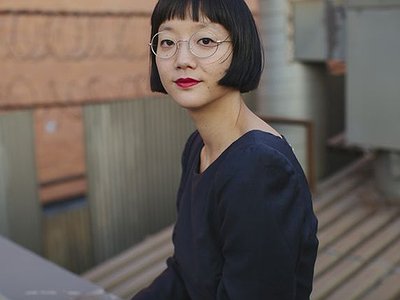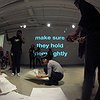When did you start writing/producing music - and what or who were your early passions and influences?
In recent years, I finally started to question the ownership of sound. It was during my residency in Berlin in 2008 where I had an epiphany after coming upon empty-looking galleries that contained only sound. The more aware I am in terms of vocal languages and/or sounds I make, the more political they turn out to be. So overly political that I want my practice to stay far away from it, but that clearly cannot be avoided.
Deaf since birth, I learnt many different ways of communicating and interacting with people who do not speak in American Sign Language. That very interaction often comes with a series of misunderstandings and plenty of flexibility and patience. The experience has been one of the biggest influences on my art practice. For example, I use iPad and iPhone to carry conversations in text and I now give partial lectures by connecting these devices to the projected screen.
What do you personally consider to be the incisive moments in your artistic work and/or career?
A few years ago, when I started my master’s in Music and Sound at Bard College’s Milton Avery Graduate School of Arts, I saw that I did not have to limit my oeuvre to low frequency sound just because I could feel its vibration and existence. With technology, science, conceptual art, linguistics, and even humour, I’m re-defining my accessibility and relationship with sound and that new and evolving mindset has been freeing me to explore every known and unknown aspect of sound. Just two years ago, I decided to become a non-traditional composer and I did that by combining several information systems in order to create visual scores and transcripts. I often encounter people’s strange but understandable expectations of me “discovering” something completely new, but what I’ve been doing thus far is to skew people’s social ideologies and norms by using sound as a form of currency, in my own terms. Bard MFA is definitely one of the top three incisive periods in my career.
What are currently your main compositional- and production-challenges?
I had an amazing residency with Recess Activities (also an incisive moment), a non-profit organization in NYC (http://www.recessactivities.org), where they offered me a series of short collaborations over 1.5 years. I invited a small number of artists, who do not speak in American Sign Language (ASL), to collaborate with me. It was a transformative experience for me as I had rarely collaborated with non-ASL speakers before then. I saw what it took to build and foster a lasting relationship with those artists, Recess folks, and participants. With those new skills, I’m much more comfortable vocalising my opinions and making decisions via email, group discussions, and so on. This is something I need to keep up with on a daily basis, so that I won’t shy away from those intense interactions again.
I suppose communication isn’t really an issue for me, but having relaxed and spontaneous conversations can pose a challenge at times. I often feel paralysed in textual English as it isn’t my first language, but I’m getting there. Also, conceptualising is difficult because my approach is heuristic and I often start with empty ideas that I need to experiment with until I finally reach the core to see what I was trying to achieve. I always work well around tight deadlines, that drives a lot of people nuts. Take note.
What do you usually start with when working on a new piece?
I find myself getting distracted, anytime, anywhere. I guess when I’m in total panic mode or completely isolated from contact with friends/strangers for an extended period of time, I’m usually in the right place to start working on a new piece. Since leaving my day job and moving out of my apartment, I’ve been up in the air and on the road non-stop ever since. I’m having some difficulty finding the balance of my new lifestyle, but hopefully I’ll get the hang of it very fast. It’s been fun being a “full timer” with art, it’s such a huge privilege.
How strictly do you separate improvising and composing?
In a sense, both are interconnected. I often try to compose with room for improvisation. Improvising without any form of structure feels like a failure to me.
How do you see the relationship between sound, space and composition?
The fact that I do not have access to sound, only my own voice (but not when it comes out of my mouth), being in control of space and composition is a way for me to maintain a degree of accessibility for myself, and a way for me to feel at ease. I once produced an audio score with field recordings I made and it felt as if I was functioning like a blind person taking random photos. From that point, it’s been all about how much control I have over sound. The more control I have, the more comfortable I am in terms of sharing sounds with the public. There was always a point in performances where it feels close to fetishising, but I guess it’s part of the game, capitalising on the exoticism of being a deaf sound artist.
Do you feel it important that an audience is able to deduct the processes and ideas behind a work purely on the basis of the music? If so, how do you make them transparent?
It depends. Generally, I’m big on museum labels because I work as a museum educator as my side job. I’m trying to keep both approaches separated, but these days, I’m finding some of my work to be quite didactic. I’m currently figuring out if it was out of my upbringing and collective obligation to keep my work accessible to the public … or perhaps, it's something I should embrace as part of my practice? I’ve noticed that when it comes to certain visual scores and transcripts, you could see all different smears left by my hands. That’s process. But as for those codes, sometimes I explain, sometimes not. It depends on my mood, surroundings, attitude, and timing. If a piece is so specific, that leaves much less room for the audience to interpret, so that a label or written biography might be necessary. I just saw this quote by Walter de Maria: “Every good work should have at least ten meanings.” If some pieces come out like that, I guess no explanation is needed.



